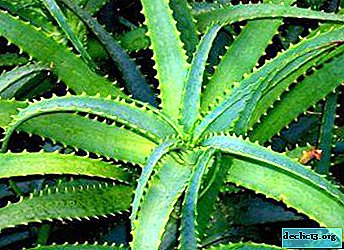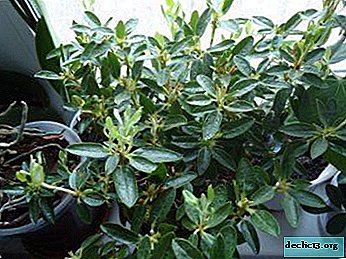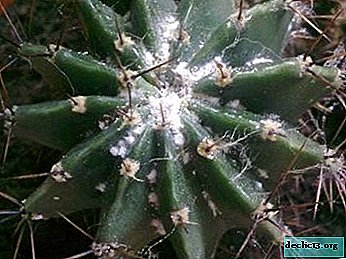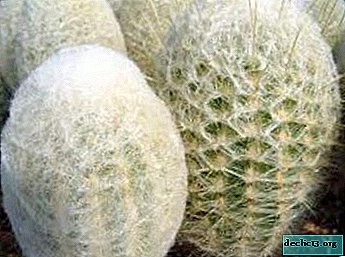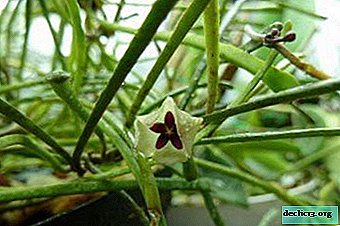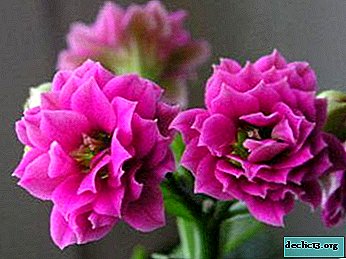Description and photos of verbena, planting and care of plants
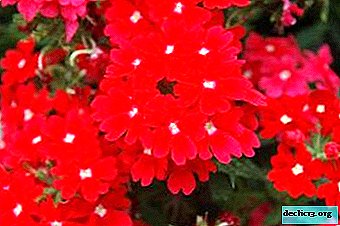
Verbena is an annual crop that is a herbaceous plant. There are two types: erect and ampelous verbena. Ampelic is characterized by hanging stems, the length of which reaches 60 cm. A grassy flower of this species is most often planted in hanging baskets, because long stems hang down. And in an erect culture, the stems are straight, and their length is 30 cm.
Verbena is a very unpretentious plant. Even an amateur can grow it, and how to properly care for a flower can be found in this article.
What is this plant?
Verbena is a highly branched plant belonging to the Verbena family.The birthplace of the flower is South America.. In the open ground, a plant is grown as an annual. It can survive only in the southern regions, as it has a low resistance to frost.
The minimum height of the bush is 20 cm. The leaves are shaggy, oval or round, have small notches. The leaf plate is light green. The root system has compact dimensions. Small flowers are collected in complex umbrella-shaped inflorescences. Depending on the verbena variety, its flowers can take the following color:
- white;
- red;
- pink;
- lilac;
- Violet.
The plant blooms from June to October. At the same time up to 30 inflorescences can bloom on one bush.
Photo
Next, you can see photos of perennial flowers:





When to plant?
Landing activities should be carried out in the spring, but more accurate dates depend on the method of reproduction.If these are seeds, then sow them on seedlings in late February or early March. If this is cuttings, then carry it out in March.
How and when to plant a flower?
The crop in question can be grown on the balcony, terrace and loggia.. At home, the most commonly found is Verbena officinalis. About the use of verbena for medicinal purposes, read here.
In the open ground
Verbena tolerates a slight decrease in temperature (-3 degrees). But prolonged cold weather will affect the plant badly. So, it is best to land in the ground in May, when the weather is warm outside, and there is no likelihood of frost returning.
The procedure for landing:
- At the site prepared for planting, you need to dig the soil. In the process of digging, add 5 kg of humus per 1 m2 and 40 g of complex fertilizers.
- Dig holes in prepared soil. Their size should be identical to the size of an earthen coma. The distance between the holes must be respected, it is determined taking into account the type of verbena. If these are compact bushes, then the distance will be 20 cm, medium - 30 cm, and large - 40-50 cm.
- Moisten the wells before planting, adding 0.4-0.5 liters of water. Set the bush and cover the hole with earth, much densifying it.
- After transplanting into the open ground, if the summer is hot, then regularly irrigate young plants until they take root.
One of the most common types of verbena, which feels good on the open ground, blooms beautifully and for a long time and looks great in drawers and pots on the veranda or in the garden - this is verbena finely divided. We talked about it in another article.
In home
 At home, verbena is planted in hanging containers:
At home, verbena is planted in hanging containers:
- Choose a spacious container with drainage holes.
- Fill it with a drainage layer (use expanded clay, 2 cm thick).
- Lay the substrate.
- Put seeds or stalk with roots.
- Add soil, compact and moderately water.
This representative of the decorative flora at home can be grown using, for example, a hanging planter. Not bad, she will feel in an ordinary pot.
Seedlings
It is necessary to engage in growing verbena for seedlings in the month of February and March.The procedure for winter and early spring at home:
- Place seeds on the surface of moistened soil in a container with drainage holes with a distance of 3-4 cm.
- Sprinkle with a thin layer of humus. Cover the container with plastic wrap, thanks to which the seeds will begin to germinate faster.
- Install a container with seedlings in a half-shaded place. As soon as the grains start to peck (1-2 weeks), provide them with full lighting and daily ventilation. To do this, remove the film for 10-15 minutes.
- Further it is important not to overdo it with watering. Otherwise, the plants will fall ill with a black leg. When watering, do not allow water to get on delicate sprouts. Pour only along the edge of the pot so that the glass liquid runs along the side to the bottom.
- When all the seeds have sprouted, the shelter can be removed completely. Subsequent care consists of regular watering.
- As soon as 3 true leaves are formed, you need to pick. To do this, use separate cups. Do this carefully so as not to injure the roots.
- Young plants need to be fed. Use better liquid complex fertilizer. You need to make it once a week. For branching and abundant flowering, the growth point is plucked over the 4-5th leaf.
- If you grow undersized hybrids, then it does not make sense to them to form a bush, since they branch perfectly on their own. Read about hybrid verbena here.
- Before planting in open ground (10-12 days), seedlings have to be prepared by exposing its balcony so that it gets used to the sun and fresh air. Such a "walk" should last 2 hours at the beginning, but every day this time should be increased by 30 minutes. And when the weather is warm, then leave the sprouts to spend the night on the street.
Advice
Verbena transplant in spring. It is very easy to do this by transferring an earthen coma. Even during flowering, the plant tolerates this procedure perfectly. The following recommendations will help in this:
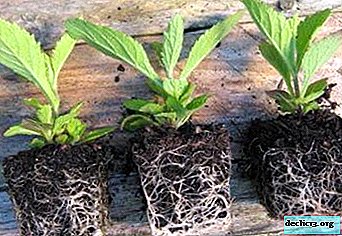 If the transplant is carried out in a container, then lay a quality drainage on the bottom. Its thickness is 2-3 cm. Use expanded clay or pebbles.
If the transplant is carried out in a container, then lay a quality drainage on the bottom. Its thickness is 2-3 cm. Use expanded clay or pebbles.- Prepare a loose and fertile substrate. If you cook it yourself, then mix 2 parts of fine sand with 1 part of peat.
- Fill the container with nutrient soil 1/3, transfer the earthen lump with a flower and add the remaining substrate.
- Water the plant and leave it for 2-3 days alone, without watering it and protecting it from direct sunlight.
How to care?
Plant care should include:
- Lighting. Verbena develops well and grows if you plant it on a consecrated site. At the same time create protection against draft and wind.
- Temperature. Verbena is a heat-loving crop. It is grown at a temperature of 16-20 degrees. With the onset of cold, the plant will die, so that in Russia it is used as an annual.
- Humidity. Verbena feels great in conditions of moderate humidity. Also periodically you need to spray the leaves of the plant with cool water.
- Watering. Regular hydration is an important event during the period of active growth and flowering of verbena. In the second half of summer, reduce the amount of moisture. Use only standing and soft water. Water 2-3 times a week.
- Fertilizers. For plant nutrition, complex preparations are excellent. You can use not only mineral compounds, but also organic matter (compost, humus). But abuse them is not necessary.Organic fertilizing should be applied only once during the whole season, since there is a high risk of oversaturation of the soil with nitrogen. Because of this, the bush will begin to actively grow greenery, not paying due attention to the process of setting buds.
- Soil loosening. These activities must be carried out to control weeds. Loosening is performed at first, until the plant has grown. But when the bush gains strength, the shoots will fill all the space on the site, so that weeds simply do not have room.
Breeding
Verbena is propagated by seeds and cuttings. The method of planting seeds was considered earlier, but the cuttings have some features:
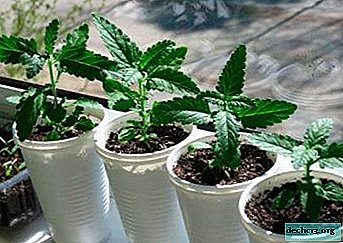 Before frosts, remove the bushes from the soil and transfer together with an earthen lump to a cool room (balcony, basement). Temperature indicators should not exceed 10 degrees of heat.
Before frosts, remove the bushes from the soil and transfer together with an earthen lump to a cool room (balcony, basement). Temperature indicators should not exceed 10 degrees of heat.- Propagation by cuttings should be carried out in early spring. If verbena is used for decoration in a house or in a warm conservatory, then this procedure can be carried out at any time of the year.
- The best cuttings are the tops of the shoots. It is necessary that they contain 4 pairs of leaves.
- A cut of the handle must be treated with crushed coal. Remove all lower leaves and leave a few at the top.
- For rooting plants, a soil mixture made from peat and sand, taken in equal proportions, is suitable. Too much cuttings should not be deepened. Do this only to the level of the first cropped leaves.
- Shortened cuttings can be wrapped with cling film, so that moisture will always be maintained in sufficient quantities.
- 3 weeks after planting, new roots will appear, and the plant can be planted in open ground or in a pot.
We watch a video about the propagation of verbena by cuttings:
Diseases and growing problems
When growing verbena, the following problems may occur:
- Root decay. The main reason lies in excessive watering. This can be prevented if you take care of quality drainage.
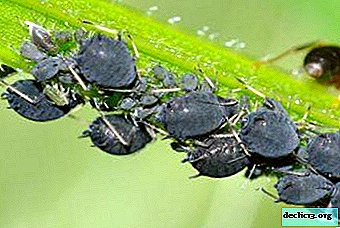 From parasites attack a plant ticks and aphids. Insecticides are used to combat them. A good result can be obtained by irrigation with tar water (5 drops of birch tar per 10 l of water).
From parasites attack a plant ticks and aphids. Insecticides are used to combat them. A good result can be obtained by irrigation with tar water (5 drops of birch tar per 10 l of water).- If the plant is affected mining flies, then bite marks are visible on the leaves. For the fight using the following insecticides:
- Ripcord.
- Nurel.
- Zinoff.
- Citcor.
- Prevention. Verbena is extremely rare. But prevention is still necessary. She intends to avoid excessive moisture in the soil, due to which the plant can affect the black leg and other viral diseases. There is no way to save the flower, so you have to get rid of it.
Growing verbena is possible for any grower, even a beginner. The main thing is to properly prepare planting material, soil and create full conditions for the growth and development of the flower. And only then will verbena thank lush flowering and beautiful views.

 If the transplant is carried out in a container, then lay a quality drainage on the bottom. Its thickness is 2-3 cm. Use expanded clay or pebbles.
If the transplant is carried out in a container, then lay a quality drainage on the bottom. Its thickness is 2-3 cm. Use expanded clay or pebbles. Before frosts, remove the bushes from the soil and transfer together with an earthen lump to a cool room (balcony, basement). Temperature indicators should not exceed 10 degrees of heat.
Before frosts, remove the bushes from the soil and transfer together with an earthen lump to a cool room (balcony, basement). Temperature indicators should not exceed 10 degrees of heat. From parasites attack a plant ticks and aphids. Insecticides are used to combat them. A good result can be obtained by irrigation with tar water (5 drops of birch tar per 10 l of water).
From parasites attack a plant ticks and aphids. Insecticides are used to combat them. A good result can be obtained by irrigation with tar water (5 drops of birch tar per 10 l of water).
